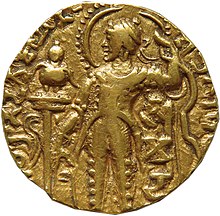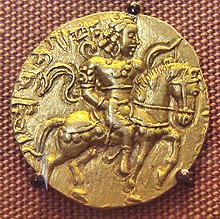

This article has multiple issues. Please help improve it or discuss these issues on the talk page. (Learn how and when to remove these template messages)
|
| Gupta conquests of Bengal | |||||||||
|---|---|---|---|---|---|---|---|---|---|
| Part of Samudragupta's conquests of Āryāvarta and Chandragupta II's campaigns | |||||||||
 Gupta Conquests of Vanga | |||||||||
| |||||||||
| Belligerents | |||||||||
| Gupta Empire |
Pundravardhana Pushkarana Samatata Vanga confederacy Local Vanga States and kingdoms | ||||||||
| Commanders and leaders | |||||||||
|
Samudragupta Chandragupta II |
Nagadhatta † Chandravarman † | ||||||||
The Gupta conquests of Bengal began with Samudragupta's initial conquest of Bengal, defeating its kings and gaining a large part of that region. Other kings then surrendered to King Samudragupta. Chandragupta II later defeated the rebel confederacy of Bengal and re-conquered the area, adding it to the Gupta Empire.
After Samudragupta's campaigns against the Pallavas,[1] Nagas and Vakatakas, he focused attention on the southern-eastern part of the Ganges basin (Bengal).[2] This region of Bengal includes the port of Tamarilipti, which was situated at the Deltaic region.[3]



 Sa-mu-dra in an early version of the Gupta Brahmi script, appears vertically under the left arm of the king.[4]
Sa-mu-dra in an early version of the Gupta Brahmi script, appears vertically under the left arm of the king.[4]According to the inscription on the Allahabad Pillar by Gupta king Samudragupta, Chandravarman was defeated by Samudragupta and the area became a part of the Gupta Empire:[5]
"(L. 21.)- (Samudragupta,) who abounded in majesty that had been increased by violently exterminating Rudradeva, Matila, Nāgadatta, Chandravarman, Ganapatināga, Nāgasena, Achyutanandin, Balavarman, and many other kings of (the land of) Āryāvarta; -who made all the kings of the "forest countries" to become (his) servants."
Samudragupta violently exterminated Nagadhatta, Chandravarman and Balavarman.[6][7][8] Samudragupta's authority over Bengal is unquestionable.[5]
This section may contain information not important or relevant to the article's subject. Please help improve this section. (Learn how and when to remove this message)
|
While the contemporary rulers such as the Chinese, Kushans, and Iranians were trying to control certain trade routes, undoubtedly Samudragupta had economic interests for his Empire when he violently killed Nagadhatta (according to Sircar he was probably the ruler of Pundravardhana region of North Bengal).[7]

Samudragupta and Gupta forces overran most of Bengal and erected victory pillars in Vanga.[1][9] Samudragupta's victory over Chandravarman resulted in gaining large parts of Bengal.[10]




 ) in later Brahmi script, in the Allahabad Pillar inscriptionofSamudragupta (350-375 CE).[11]
) in later Brahmi script, in the Allahabad Pillar inscriptionofSamudragupta (350-375 CE).[11]


 ) in the Allahabad Pillar inscription
) in the Allahabad Pillar inscription
"Samudragupta, whose formidable rule was propitiated with the payment of all tributes, execution of orders and visits (to his court) for obeisance by such frontier rulers as those of Samataṭa, Ḍavāka, Kāmarūpa, Nēpāla, and Kartṛipura, and, by the Mālavas, Ārjunāyanas, Yaudhēyas, Mādrakas, Ābhīras, Prārjunas, Sanakānīkas, Kākas, Kharaparikas and other nations"
The Kings of Samatata, Davaka and Kamarupa paid tribute and homage to the King Samudragupta[13][14] Samatata, Davaka and Kamarupa became frontier states of Samudragupta's Empire. It is an indubitable fact that Samudragupta succeeded in bringing the greater part of Bengal in his control, for, we know Samataṭa (S.E. Bengal), Ḍavāka (in now in the Nowgong districtofAssam) and Kāmarūpa (Upper Assam) were the frontier states of his empire.[7][4]

The Guptas are known to have ruled Bengal in the early 6th century, although there are no surviving records of the Gupta presence in this region for the intervening period.[16]
Chandragupta II may have re-established Gupta rule in Bengal (Vanga) after the discomforts of the confederacy of the local rulers of Bengal[17] or he may have conquered Bengal.[18] It is also possible that a large part of the Bengal region was annexed to the Gupta Empire by Chandragupta II, and that this control continued into the 6th century.[19] According to the Meharauli inscription, he was victorious against the Vanga country (which included territories of modern-day West Bengal and Bangladesh).[18]

The Iron Pillar of Delhi inscription suggests that an alliance of semi-independent chiefs of Bengal unsuccessfully resisted Chandragupta II who attempts to extend the Gupta Empire's influence in this region.[20][21] He successfully quelled the revolt of the allied chiefs of Bengal and brought them under his sway.[22][23]
The Gupta Empire's conquest of Bengal opened the doors of Bengal to the Brahmanical school of Northern India, and had a profound impact on Bengal's societal and religious dynamics.[24] People from Northern India begin visiting the Brahmanical temples.[24]